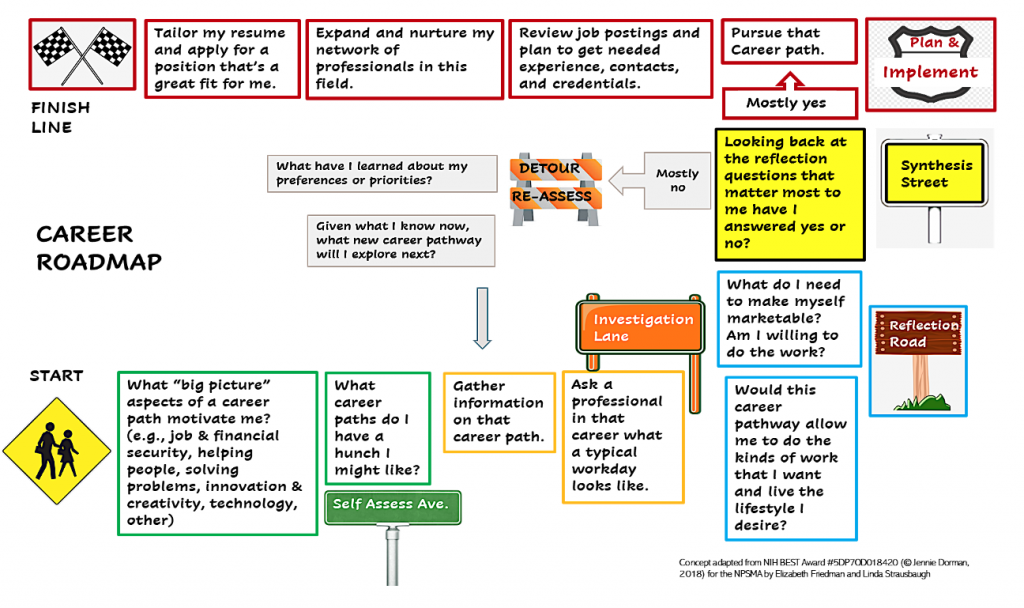Published on
A Career Roadmap for Master’s Students in STEM

When it comes to making informed decisions about career choices, master’s students are often short-changed by their educational institutions. Their programs are quick to complete, some just one year long, and their advisors often don’t have enough time or resources to help them investigate and explore career opportunities. Thus we thought, what if we gave the students this additional guidance? What if we provided M.S. students in STEM with a career tool written specifically for them? In essence, what if we provided them with a roadmap to help them navigate career choices? After not finding any easily accessible, existing STEM master’s navigation tools, we decided to create our own student-centric, self-directed Career Roadmap.

We designed this Career Roadmap to help individuals explore a variety of career paths. It particularly helps them understand what their career choices mean in terms of job satisfaction, skill preparation and competencies needed. The Career Roadmap also helps students explore careers they may not have initially thought of when they enrolled in their master’s program.
We based our Career Exploration Road Map on one that had been intentionally created for doctoral candidates and postdoctoral fellows (NIH BEST Award #5DP7OD018420 © Jennie Dorman, 2018). To address the differing needs of master’s students, we retrofitted the existing roadmap to better serve the shortened time-to-degree and career preparation. Our STEM M.S. Career Roadmap more greatly emphasizes career exploration: self-reflection, assessment of skills and competencies and professional networking.
Our Career Roadmap helps by asking students early on to identify the big-picture aspects that motivate them and to consider the kinds of lifestyles they prefer. Part one of career exploration is knowing what one will actually be doing on the job. Part two is knowing oneself. Finding a good match requires putting these two parts together. In iterative fashion, students will discover more about themselves as they learn about the day-to-day activities of potential job opportunities.
The Career Roadmap assumes that students often don’t know what the job they are seeking actually entails, what skills and competencies are required. How do these students find out what they will actually be doing? Job descriptions may give some indication; however, student experiential learning initiatives often provide a more realistic image of what the job is really all about. Job shadowing, informational interviews and internships are great ways to learn more about career choices. After this initial research phase, students may be surprised to find that they may not be suited for the particular job they had in mind while finding other related positions that may be of more interest.
In our Career Roadmap, we emphasize that not every job is suitable for every individual, no matter how qualified they are. For example, achieving a well-paid job as a data scientist is a wonderful goal for some people but may not be the best career path for data geeks who seek more social interaction. Some students love biochemistry but would feel more satisfaction going into counselling or medicine, where they have more of a direct impact on human lives than working in a scientific laboratory. The Career Roadmap helps students figure out these decisions.
The Career Roadmap helps STEM M.S. students explore and investigate a myriad of different career possibilities and research the courses, skills and competencies required of each. It is reminiscent of the Game of Life™. The roadmap not only gives directions but prompts the student to take action and adopt a more involved role in their career exploration. Once initial career choices are made, the Career Roadmap helps students prepare themselves for the chosen career path. Self-directed research helps the student understand what skills and competencies they need, what they already possess and how to obtain what they lack.
The Career Roadmap is written in a way that accounts for moments of indecision and times in one’s personal life that may set the student off course—moments that ultimately turn into detours or road bumps but that are part of the journey. This tool encourages students to recognize these life events. It is a visual aid, peppered with decision-making steps, allowing for these so-called unexpected moments. In other words, inherent is the idea that master’s students may not have a beeline toward their ultimate job. Their path may be full of twists and turns.
Master’s degree students have such a short time to make decisions with larger-than-life impact on their future. Their academic advisors, as a result of institutional priorities, may not have the bandwidth to address their needs. This is especially true when advising time is limited. Many colleges rely on career services departments, but they are often overwhelmed and under-resourced, focusing more on resume writing and interview skills than career exploration and preparation.
From encouraging career exploration to reflecting on the job fit, the roadmap, as presented here, is part of a much larger career tool: the STEM Master’s Individual Development Plan (msIDP). The msIDP ©2022 is in its beta-testing phase and is currently available to students of select professional science master’s programs affiliated with the National Professional Science Master’s Association (NPSMA). In the future, we hope to make it available to a much wider range of master’s degree-seeking and Continuing Education students.
Creating the STEM M.S. Career Roadmap and the larger msIDP of which it is part, was, fittingly, a long and winding road. Three years ago the NPSMA and Council of Graduate Schools (CGS) received funding from the National Science Foundation NSF) to begin a collaborative project exploring the need for IDPs in master’s education (NSF Award Abstracts #1940221 and #193934). This funding sponsored two major activities: a survey of 80 unique higher education institutions to query current M.S. advising practices and areas of priority, and a follow-up in-person workshop to develop recommendations for further research. The actual development of the Career Roadmap and msIDP was not supported by this funding but was the result of a group of strongly committed academic professionals who donated their time and energy to provide suggestions, review and revise documents, and implement and beta-test the msIDP. Those involved in the survey—the workshop organizers and participants—were all volunteers. Moving a project like this forward takes strong commitment from like-minded people passionate about student success.
Students who use the Career Roadmap and subsequent msIDP will be meeting both workforce demands and their own personal needs. By keeping track of STEM employment opportunities, helping students recognize the courses, skills, and competencies needed for such job openings, and discovering better matches between students and employers, we will have a much stronger, better prepared workforce. The STEM M.S. Career Roadmap we’ve designed is just the beginning of this process.
Author Perspective: Administrator


